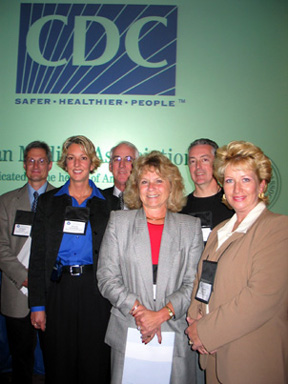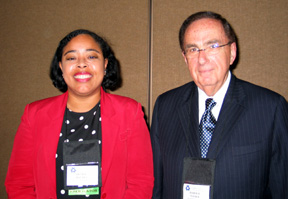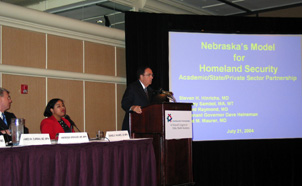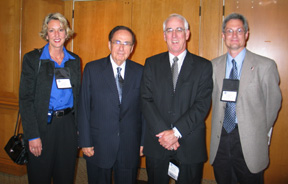 |
Part of the Nebraska contingent at the conference were, left to right: Tony Sambol, UNMC; Joann Schaefer, M.D., Richard Raymond, M.D. and Chris Peterson, Nebraska Department of Health and Human Services System; Gary Gorby, M.D., Creighton University; and Sharon Medcalf, UNMC. |
UNMC Chancellor Harold M. Maurer, M.D., and Richard Raymond, M.D., chief medical officer of the Nebraska Department of Health and Human Services System, made presentations during the conference that brought together leaders and decision makers from medicine, public health and academia.
Goals of the conference included strengthening the link between health care and public health leaders, sharing successful experiences that have improved community readiness for terrorism and naturally occurring public health threats, and reviewing new scientific advancements.
Dr. Maurer presented details of a Nebraska model which epitomizes a partnership between Nebraska government, academia and private industry, during a panel session titled, “Academic Institutions — Moving Thought to Practice.” Nebraska’s model for readiness has been lauded by CDC officials and others around the country. Components include: data collection, analysis and security; communication strategies; rapid testing; syndromic and agricultural surveillance; and continuity of operations during an emergency.
Dr. Raymond’s presentation focused on “Examining Economic, Program and Opportunity Costs of Readiness.” He said the conference reaffirmed his believe that Nebraskans are on the right track in public health preparedness.
“After two days at this conference, I walk away with the impression that what we’re doing is on target,” Dr. Raymond said. “I’m feeling very good about where we’re at. But we’re not done. We’ll never be done.”
 |
Denise Holmes, J.D., assistant vice president and director of global health, Association of Academic Health Centers, and Harold M. Maurer, M.D., UNMC chancellor. |
Harrison Spencer, M.D., president and chief executive officer, Association of Schools of Public Health, and Denise Holmes, J.D., assistant vice president and director of global health, Association of Academic Health Centers, moderated the panel.
Holmes said UNMC came to mind when she and conference planners looked around for academic medical centers engaged in outstanding work in the area of bioterrorism. “We looked for those engaged in exemplary work who are truly amazing and whose story needs to be shared with the rest of the country,” Holmes said.
“The state of Nebraska has a model that’s pretty unique,” Dr. Maurer said. “We’re told we’re unique wherever we go. People refer to our model. I feel honored we’re so involved even though we’re a small state. It’s a real kudos for the state.”
 |
UNMC Chancellor Harold M. Maurer, M.D., highlights the Nebraska bioterrorism model that epitomizes a partnership between Nebraska government, academia and private industry during the First National Congress on Public Health Readiness in Washington D.C. |
The CDC has noted other areas of success from Nebraskans, including the work of Tony Sambol, coordinator of special pathogens and bio-security laboratory sections, Nebraska Department of Health and Human Services System’s Nebraska Public Health Laboratory (NPHL). The lab is on the UNMC campus.
Before the anthrax incidents in 2001, Sambol had developed and distributed to 100 laboratories statewide, a CD-ROM that outlined lab and reporting procedures for bioterrorism.
Rex Astles, Ph.D., senior health scientist, U.S. Centers for Disease Control and Prevention (CDC), said Sambol’s work was indispensable to the CDC.
“The CDC depends on the states for everything,” Dr. Astles said. “He recognized the need to assess what reporting practices and testing needs to happen in the state. He did that in a systematic way and then began to create a network. All of public health depends on surveillance. Almost all surveillance depends on clinical labs.
 |
Left to right are: Nebraska Joann Schaefer, M.D., deputy chief medical officer, Nebraska Department of Health and Human Services System; Harold M. Maurer, M.D., UNMC chancellor; Richard Raymond, M.D., chief medical officer, Nebraska Department of Health and Human Services System; and Tony Sambol, coordinator of special pathogens and bio-security laboratory sections, Nebraska Department of Health and Human Services System’s Nebraska Public Health Laboratory, located at UNMC. |
“The CD-ROM was so effective we decided to mass produce copies of it and FedEx it out to the 4,400 labs in the country. Because of this model, the work was available. We were fortunate,” he said.
Donna Knutson, deputy director, Office of Terrorism Preparedness and Emergency Response, CDC, said the country has come a long way in public health preparedness since the Sept. 11 attacks.
“We’ve invested $2.7 billion dollars in the last three years, and 3,800 public health workers now work on this that didn’t before. About 95 percent of the states have the ability to test for anthrax.” She said Chicago officials’ participation in the smallpox vaccination program enabled them to meet the vaccination challenge when the meningitis and Hepatitis A outbreaks occurred.
Disaster preparation, however, is ongoing. “We cannot say we’re done,” Knutson said. “We can say we’re in a much better place. We’ve got specific outcomes we want states to accomplish. We now also have a handful of states that are trained in the Strategic National Stockpile (SNS).”
The SNS is a national repository of drugs, equipment and supplies that can be transported and used rapidly to supplement and re-supply state and local public health agencies in the event of a national emergency.